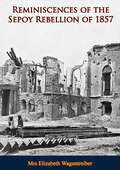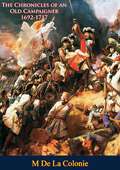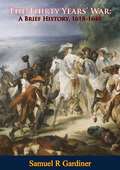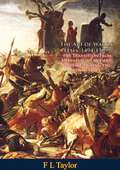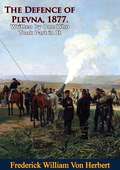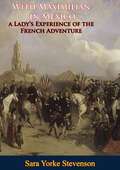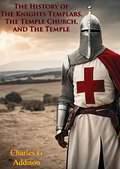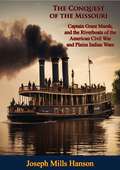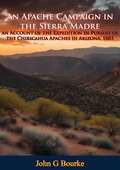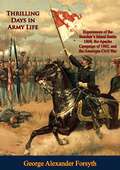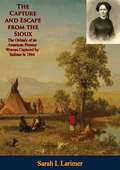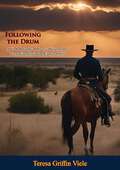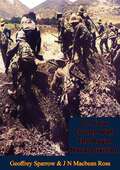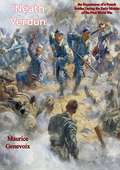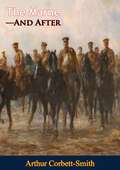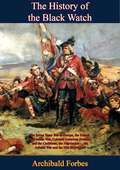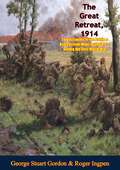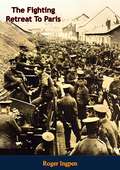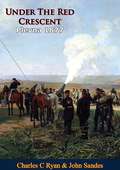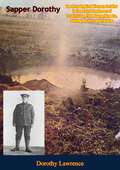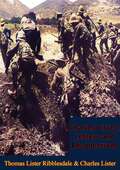- Table View
- List View
Reminiscences of the Sepoy Rebellion of 1857
by Mrs Elizabeth Wagentreiber“Elizabeth Wagentreiber was the youngest daughter of Colonel James Skinner of the famous cavalry regiment 'Skinner's Horse'. She had originally married a Captain Radclyffe Haldane, an officer of Skinner's Horse who was killed at the Battle of Chillianwallah during the Second Anglo-Sikh War. She subsequently married George Wagentreiber. And in the Spring of 1857 the couple were living in the civilian lines at Delhi when the Indian Mutiny broke out in the Bengal Army and reports arrived that the native cavalry was running amok in the city, slaughtering Europeans. Fearful for their lives the couple escaped with their children and the harrowing account of their time as fugitives makes compelling reading.”-Print ed.
The Chronicles of an Old Campaigner 1692-1717: The Recollections of a French Dragoon Officer During the War of Spanish Succession
by M De La Colonie“An essential first hand account from a French soldier.Personal accounts by French soldiers have not proliferated in the English language and those that concern the Napoleonic Wars are much sought after by readers and invariably repay the effort to find them with an interesting tale, compellingly told. This account concerns another period some one hundred years or so before the time of the First Empire, but it too is a first rate personal account full of anecdote, drama, duelling, camp and campaign life, battles and sieges that will not disappoint. This highly regarded French soldier fought in the War of the Spanish Succession-among others-and so the reader will understand what warfare was like on the other side of the lines from the great Duke of Marlborough and his ally, Eugene of Savoy. Seconded to service by the Elector of Bavaria, the author was a committed and aggressive soldier who, together with his French contingent, invariably found himself in the thick of the action. This is an essential and riveting narrative from the time when central Europe was boiling with dispute and the Bourbon monarchy was at the pinnacle of its power and influence. Highly recommended.”-Print ed.
The Thirty Years' War: A Brief History, 1618-1648
by Samuel R Gardiner“A concise history of a cataclysmic European conflict in the 17th centuryThe Thirty Years' War was fought between 1618-1648 and is widely recognised as being one of the most destructive wars ever fought. More people lost their lives in this conflict, as a percentage of the total population at the time, than in the conflicts of the twentieth century. Fought principally in central Europe—and mostly over terrain now in modern day Germany—the war involved more than fifteen nation states. Forces were divided broadly on religious grounds, between Protestants and their allies and the Catholics of the Holy Roman Empire and Spain but also with elements of the Ottoman Turkish Empire. Self evidently this was a long, bloody conflict the causes of which were many and complex. Dynasties were born in its tumult, great men were brought to the fore and some, like Gustavus Adolphus of Sweden, would perish before its conclusion. The campaigns and battles of the Thirty Years' War have inspired historians across the centuries to the present day to write about them and many highly regarded works concerning the war have been published. This concise book takes a different approach; it sets out to give an understanding of the events and personalities involved and is an ideal overview for both specialists and those new to the subject.” – Print ed.
The Art of War in Italy, 1494-1529: the Transition From Mediaeval to Modern Warfare During the Renaissance
by F L Taylor“The birth of 'New War' in ItalyIt is easy to consider the Renaissance as a time of enlightenment typified principally by the artistic and scientific genius of Leonardo da Vinci and his peers; but giant leaps forward are never confined to one aspect of society and the application of new ideas is always adapted to various purposes and the meeting of differing objectives. The creation of modern political science by Niccolo Machiavelli is a prime example of how new ways of thinking and doing impacted on the advancement and securing of power. These changes were inevitably accompanied by significant developments in making war more effectively, strategically and tactically-with corresponding advances in weaponry and other equipage. This excellent book considers these developments through the changes to traditional military strategy and the use of infantry, cavalry and artillery, in both open battle and fortification and siege-craft, at the turn of the sixteenth century.”-Print ed.
The Defence of Plevna, 1877. Written by One Who Took Part in It
by Frederick William Von HerbertIn "The Defence of Plevna, 1877," readers are transported to the heart of one of the most pivotal moments in European history. Set against the backdrop of the Russo-Turkish War of 1877-1878, this gripping narrative chronicles the epic struggle for the Bulgarian town of Plevna.As the Russian Empire seeks to expand its influence in the Balkans and challenge Ottoman dominance, the small garrison town of Plevna becomes the focal point of a fierce and relentless battle. Led by the indomitable Ottoman commander, Osman Pasha, the defenders of Plevna are faced with overwhelming odds as they confront the might of the Russian army.Against the backdrop of political intrigue, military strategy, and personal drama, the fate of Plevna hangs in the balance. Will Osman Pasha and his valiant defenders withstand the onslaught of the Russian forces, or will the town fall, signaling a turning point in the course of history?"The Defence of Plevna, 1877" is not just a tale of warfare, but a testament to the human spirit in the face of adversity. It is a story of courage, honor, and the enduring struggle for freedom and independence. This book is essential reading for anyone interested in military history, the Balkans, or the complex dynamics of 19th-century Europe.
Ghenko: The Mongol Invasion of Japan, 1274-81
by Nakaba Yamada“A ferocious conflict between Mongol and Samurai.The Japanese word 'Ghenko' is the term employed for the Mongol invasion of Japan. The event was an immensely significant one for the Japanese and it remained so for centuries because, in part, the defeat of the invaders was attributed to divine intervention. There can be little doubt that Japan's salvation had much to do with the fact that they are an island race and in that they have much in common with other islanders, Great Britain among them, who on more than one occasion might claim the sea as their principal and most powerful ally. Indeed, the author of this book draws parallels with Britain and the Spanish Armada. The Mongols had rapidly risen to power during the 13th century and had created an unstoppable empire that spread over huge areas of land from the Yellow Sea of Asia to the Danube in Europe. Although massively stronger than the Japanese, the Mongols attacked the Japanese islands, attempting domination by invasion and yet were repulsed with finality. To modern students of military history the contents of this book has a compelling allure, since there can be no doubt that in the Mongol warrior and the Japanese Samurai there resided a martial spirit and expertise which, perhaps inevitably, could not both exist in the same sphere, but which in collision could not fail to instigate conflict of the most singular kind. This account of the clash between the ultimate warriors of their day analyses this time of warfare in superb detail. An essential addition to the library of anyone interested in the warfare of the East.”-Print ed.
With Maximilian in Mexico: a Lady's Experience of the French Adventure
by Sara Yorke Stevenson“A remarkable experience of little reported events.The Second Empire of France was, by the early 1860's in good health. France had acquitted itself well in the Crimea and in the war against Austria. The idea of a European monarch on the throne of Mexico was not a new one. France was attracted to the idea of a 'Latin' influence in America and thus the opening chords were struck of what would eventually be—to quote the author—'A Dance of Doom', the steps of which would lead the Archduke Maximilian to a stark wall there to be riddled with bullets from a Mexican firing squad. The author of this account—a young American woman living in Paris—was swept up in these extraordinary events and found herself in Mexico amongst its most influential figures. This is her essential and riveting story of turmoil and rebellion.”- Print ed.
The History of The Knights Templars, The Temple Church, and The Temple: Large Print
by Charles G Addison“The warrior knights of the crossThe Knights Templar were one of the most famous Christian military orders of the medieval period. Officially endorsed by the church in the early decades of the 12th century the express purpose of the order was to provide defence and protection to Christian pilgrims. The concept became a popular one and with patronage came wealth and power so that the order, through a substantial infrastructure of non-warrior members spread throughout Europe promoting its objectives, developing financial institutions and building fortification on a grand scale. However, the Knights Templar are especially remembered today for the prowess of their military knights. Clad in white mantles bearing the distinctive red cross the Templars both attracted and created some of the most expert and effective fighting men of their time. Naturally, the order was closely connected to the Holy Land and with the Crusades. For some two hundred years it fought the forces of Islam for dominance of Jerusalem experiencing mixed fortunes in dozens of actions and major battles. The eventual loss of the Holy Land could do no other than promote a decline in their fortunes, and indeed, the support for the Templars. Furthermore, the order's wealth and its independent structure, wielding power outside state and church, inevitably made it a target for both suspicion and dissolution. The end came in 1312—in a welter of torture, bloodshed and burnings at the stake. The legend has lived on however, and today the times of Knights Templar are to many more intriguing and evocative than ever.”-Print ed.
The Conquest of the Missouri: Captain Grant Marsh, and the Riverboats of the American Civil War and Plains Indian Wars
by Joseph Mills Hanson“A great river and those who sailed it.This well known and highly regarded classic of the opening up of the American West concentrates on the great rivers of North America and the Missouri in particular. Focus is, of course, placed to the iconic paddle-steamers, their captains and crews, that plied its waters and that have become emblematic of river navigation in 19th century America. The scope of the narrative is significant. Events are described from the mid-1850s and through the American Civil War. However, the book principally deals with the post Civil war period of westward expansion and the role of the vessels and the river itself in the wars against the plains Indians. The transportation of troops and materials played a significant part in these campaigns and this is, of course, is recounted here in some detail. Readers will learn about the exploits of boats including the 'Far West, ' 'Key West, ' Rosebud, ' 'Luella' and 'North Alabama' in this fascinating account of the American frontier afloat.”-Print ed.
An Apache Campaign in the Sierra Madre: an Account of the Expedition in Pursuit of the Chiricahua Apaches in Arizona, 1883
by John G Bourke“With Crook in pursuit of Geronimo and his band.The author of this book was a U.S. soldier in addition to being a well known and highly regarded author on the Apache Wars of the later nineteenth century-in which he was an active participant. He maintained an interest, respect for and in some measure an affection for the Apaches and he also made a serious study of and wrote notable works on their customs and culture. He is perhaps best known for his classic account of the Apache Wars, 'On the Border with Crook.' This small account was written prior to his larger and more expansive work. It originally appeared as a series of articles in the Boston published 'Outing Magazine.' Bourke decided to bring his earlier writings back into print in book form, at a time when the Apaches had once again taken the war trail, to provide the American public with context to then current events. This fascinating account, which centres on the events of the Spring of 1883, concerns Crook's pursuit of the Chiricahua Apaches who broke out of San Carlos reservation to raid through Arizona and Mexico before vanishing into the fastness of the Sierra Madre. Those with any interest or knowledge in this subject will find themselves familiarly introduced to the corps of Apache Scouts, Al Sieber (Zieber), the scout and interpreter, Crook, Gatewood, Chato and of course the renowned Geronimo, as well as other names long associated with this remarkable time in the history of the Apaches and Arizona.”-Print ed.
Red Eagle and the Wars with the Creek Indians of Alabama 1812-1814
by George Cary Eggleston“Red Sticks, White Sticks and the war in AlabamaThe Creek Indian War, also known as the Red Stick War, took place between 1813-1814 and has been considered by many historians as part of the War of 1812. The Creek—or Muscogee—Indians of Alabama were effectively waging a civil war among themselves. One militant faction, the so called Red Sticks, proposed an aggressive return to the traditional life of their forebears and an end to treaties with and concessions to pioneer settlers represented by the United States government. The White Sticks, opting for peace, inevitably took the opposing view. Although the conflict began as one between the indigenous Indians, American forces, under the soon to be famous Andrew Jackson among others, were drawn into the conflict because much of the animosity was focussed on pioneer settlements. The conflict started in the usual manner of American Indian Wars—with the murder of settler families. The inevitable revenge and retribution that followed—and an escalation of the kind of merciless savagery the Americans had come to expect—culminated in the massacre of 500 settlers, friendly Indians, mixed blood Creeks and soldiers at Fort Mims in an attack led by the Red Stick war leader, Red Eagle. Other forts were also attacked. Panic spread through the region exacerbated by the inability of the Federal government to provide ready aid since it was engaged against the British and their Indian allies to the east. As a consequence much of the fighting was undertaken by militias from Tennessee, Georgia and Mississippi supported by White Stick allies. National hero, Davy Crockett, also served in this conflict. The war ended in a victory for the Americans and put Andrew Jackson on a path to the presidency and the White House. It was a disaster for the entire Creek Indian tribe—irrespective of their allegiances—who paid for the conflict through the confiscation of vast tracts of their traditional lands.”-Print ed.
Thrilling Days in Army Life: Experiences of the Beecher's Island Battle 1868, the Apache Campaign of 1882, and the American Civil War
by George Alexander Forsyth“A highly regarded memoir of the Indian and Civil Wars.The author of this book, George A. (Sandy) Forsyth was a career soldier who served with distinction in the American Civil War and subsequently upon the western frontier against the Plains Indian tribes as they fought a losing battle to stem the inexorable advance of 'Manifest Destiny'—essentially 'the survival of the fittest'—'the law' as Forsyth writes, 'that has obtained since the dawn of creation.' Forsyth's career was varied and full of incident, though in his biography he has elected to concentrate on just four outstanding episodes in which he took part. The first, and certainly the one for which has remained famous to this day concerns the Battle of Beecher's Island. In 1868 in command of just 50 'scouts' Forsyth pursued a thousand Indian warriors of the Northern Cheyenne and other tribes under the war chief, Roman Nose, and found himself besieged on a small island in a creek of the Republican River. This incredible story of endurance has become one of the iconic episodes of the Plains Indian Wars. Here Forsyth tells his experiences in his own words before recounting a lesser known incident from his time on the Mexican border in conflict with and pursuit of Chiricahua Apaches. The final two accounts concern Forsyth's experiences as an aide to Sheridan during the Civil War, first during the Shenandoah campaign and finally at Lee's surrender at Appomattox Court House after the last shots of the war were fired. Forsyth intends to grip his reader from first page to last by the exclusion of the routine of drudgery of military life and by focusing on its moments of high action. He succeeds and has created a highly entertaining account of military adventure of the United States Army of the nineteenth century which will satisfy every reader.”-Print ed.
The Capture and Escape from the Sioux: The Ordeals of an American Pioneer Woman Captured by Indians in 1864
by Sarah L Larimer“A famous account of abduction and escape from hostile Indians in the old West.In July, 1864 hostile Oglala Sioux Indians attacked the wagon train of the pioneering Kelly and Larimer families approximately 80 miles west of Fort Laramie, Wyoming. Several people were killed or wounded but Sarah Larimer and Fanny Kelly, together with some of their children, were taken into captivity by the Indians. On the second night of their captivity Sarah Larimer and her son managed to escape from the Indian camp and after many difficulties and privations they reached the Deer Creek telegraph station and safety. This book is Sarah Larimer’s story of her ordeal. Fanny Kelly’s captivity with the Sioux lasted longer and on her release she also wrote a book about her experiences. She also sued Sarah Larimer over her memoir and several trials took place over ten years before the matter was settled. [This Book] provides fascinating insights into the westward passage of pioneer families in North America, and those interested in the Indian tribes of the Great Plains during their struggle to maintain their traditional way of life will also find much to interest them in the pages of these books.”-Print ed.
Following the Drum: A U. S. Infantry Officer's Wife on the Texas Frontier in the Early 1850's
by Teresa Griffin Viele“A view of the early Texan frontier from a female view pointTeresa Viele was a strong minded woman with clear cut views. Fate would dictate that her life would not be defined by her experiences as an army wife, but in this book she has left us a significant insight into the activities of the officers, soldiers and families of a United States Infantry regiment on the Texas frontier in the pre-Civil War period. Her account encompasses everything that came under her eye and into her active mind-from travel, landscape, flora, fauna and food. Less domestically, she turned her thoughts and pen to the subject of Mexicans and United States political relations with Mexico, the omnipresent threat of Comanche raiders and the ability and capacity of the army to fulfil its border protection duties. Viele also provides an interesting perspective on Jose Maria Jesus Carbajal and the Merchants War. This is an unusual female viewpoint on life on the early South Western American frontier and is an important chronicle of a woman in Texas during the pioneer period.”-Print ed.
On Four Fronts with the Royal Naval Division
by Geoffrey Sparrow J N Macbean Ross“The Blue Jackets who fought on landThe time of Nelson was not only notable because of the success in nautical warfare of the man himself, but also because it was the zenith of the 'age of sail' that left British sea power so dominant that Britannia really did 'rule the waves.' No navy could stand against the might of the Royal Navy, and so until Jutland during the Great War it would not fight another major battle at sea. Queen Victoria's ever expanding empire meant that British forces were perpetually set against often underdeveloped powers and the navy took its part, but most of the hard work of empire building would inevitably fall upon the British army. Of course, the Royal Navy had its own 'soldiers'—the Royal Marines. The particular talents and skills of sailors were often required, particularly whilst manning 'the guns, ' so the 19th century saw the 'blue jackets' in action in the Crimean War, the Indian Mutiny, the Zulu War, the Boer War and several other conflicts. The early years of the 20th century brought a period of instability that inexorably dragged the great powers of Europe towards the cataclysm of blood which was to be the Great War of 1914-18...The Royal Naval Division was formed around a cadre of Royal Marines and sailors and was expanded as a unit of the New Army by volunteers. The Division saw action in the defence of Antwerp in 1914, on Helles and Anzac during the disastrous Gallipoli Campaign in 1915 and on the Western Front where it took part in the Battle of the Somme in 1916 and the Third Battle of Ypres in 1917. This book was written by one of the their number and is an often light-hearted account of the wartime record of the division, full of incident and anecdote and scattered with occasionally humorous line drawings. There is little in print about the Royal Naval Division in the First World War so this will make a welcome addition to any naval library.”-Print ed.
'Neath Verdun: the Experiences of a French Soldier During the Early Months of the First World War
by Maurice Genevoix“The war of the French volunteersThis book does not concern the Battle of Verdun in 1916—widely considered to be the largest battle in world history, rather it positions the action geographically for the reader. Written during wartime this account concerns the personal experiences of a young officer of the French infantry from the earliest days of the Great War through a period of comparative fluidity of movement before the stalemate of trench warfare. The fighting concerns the actions about the Meuse and the Marne in the first year of the war from a French perspective and concludes as the 'armies go to earth' in the early part of 1915. Genevoix takes the reader into the heart of his enthusiastic young group of comrades and soldiers on campaign to provide valuable insights into the opening phases of the great conflict the French infantry knew.”-Print ed.
The Marne—And After: A Companion Volume To The Retreat From Mons (classic Reprint)
by Arthur Corbett-SmithIncludes The First World War On The Western Front 1914-1915 Illustrations Pack with 101 maps, plans, and photos.“An outstanding first hand account and history of the first battles of the Great War The Great War had long been planned by Imperial Germany and its army stood ready to advance through Belgium and France with a force of overwhelming superiority. Both the Belgian and French nations rushed to arms, but were overwhelmed. The small British regular army in the form of the B. E. F was mobilised and thrown into the battle line in a matter of days. It met the advancing German masses at Mons and, much to the astonishment of the enemy, who allegedly referred to the B. E. F as that 'contemptible little army, ' gave a superb account of itself. However, no army of its size could hold against the numbers that opposed it and it was inevitable that it would be overrun. So began one of the most outstanding achievements in the history of the British Army, the dogged retreat from Mons. The man of the hour was undoubtedly Smith-Dorrien, commander of II Corps, who, when it was clear that retreat was no longer possible, saved the army from annihilation when he ordered his men to stand and fight around Le Cateau. The allies halted before Paris, turned and began a counter offensive across the Marne and Aisne that rolled the German invaders back to Ypres. Arthur Corbett-Smith was an officer of the Royal Horse Artillery and was present throughout the events described here. His first-hand experiences, anecdotes and history of the campaign are a highly readable narrative which delivers the facts of the events of Summer and Autumn, 1914.”-Print ed.
The History of the Black Watch: and the Caribbean, the Napoleonic ... the Ashanti War and the Nile Expedition
by Archibald Forbes“The first 150 years of one of the British Army's most renowned regiments Archibald Forbes was a notable author, journalist and special correspondent during the British colonial wars of the Victorian era, so he was well positioned by personal experience to pen this history of a famous Scottish Highland regiment. 'The Black Watch, ' 'The Forty-Twa, ' the '42nd Regiment of Foot, ' 'The Royal Highlanders'—First to come, Last to go. The titles of this legendary regiment are many and its fame well and hard earned on many a bloodily contested ground from its birth to the present day. Forbes wrote his own history from the perspective of his own time-—a decade before the close of the nineteenth century. We join the regiment in these pages during the Seven Years War in Europe and in its theatre of the New World—popularly known as the French and Indian War—where the regiment would pay dearly before Ticonderoga. The Black Watch had not done with Indians as it fought to secure the backwoods frontier, notably at Bloody Run and Bushy Run. The American War of Independence was followed by the war against Napoleonic France which would see the regiment in service in Egypt, in battles across the Peninsula, at Corunna with Moore and, as the epoch came to an end with the Emperor's fall, with great loss at Quatre Bras and Waterloo with Wellington. More hard soldiering came in the Crimea and this valiant force was the hand of retribution in the Indian Mutiny. The book closes with encounters with the Ashanti and the expedition to relieve Gordon in Khartoum.”-Print ed.
The Great Retreat, 1914: During the First World War [Illustrated Edition]
by George Stuart Gordon Roger IngpenIncludes The First World War On The Western Front 1914-1915 Illustrations Pack with 101 maps, plans, and photos.“Two views of the Great RetreatImperial Germany had long planned the conflict that was to become the First World War, but when the onslaught came there was little sign that the nations which would be embroiled were prepared for the storm. Germany advanced in the east and west where French and Belgian armies were forced to retire by overwhelming odds. The small British Army, the 'B. E. F', was rushed to the continent with most of its troops having less than a week between garrison life and the firing line. Under Sir John French, it was allocated the western end of the line, and at Mons it inflicted far more causalities on the enemy than its numbers would suggest. No army of its size, however, could stand against the German superiority in men (at least five to one) or artillery and machine guns. An envelopment was inevitable and so a stubbornly fought retreat was ordered. Near Le Cateau, the British turned at bay and Smith-Dorrien's determination to stand and fight undoubtedly saved the British Army from annihilation. Many people imagine the First World War as a stalemate of mud, wire and trenches, but in the first six months it was a great European war fought in much the same way that Napoleon, Wellington and Blucher had fought a century before.”-Print ed.
The Fighting Retreat To Paris
by Roger IngpenIncludes The First World War On The Western Front 1914-1915 Illustrations Pack with 101 maps, plans, and photos.A fascinating view of the opening phases of the First World War.“Imperial Germany had long planned the conflict that was to become the First World War, but when the onslaught came there was little sign that the nations which would be embroiled were prepared for the storm. Germany advanced in the east and west where French and Belgian armies were forced to retire by overwhelming odds. The small British Army, the 'B. E. F', was rushed to the continent with most of its troops having less than a week between garrison life and the firing line. Under Sir John French, it was allocated the western end of the line, and at Mons it inflicted far more causalities on the enemy than its numbers would suggest. No army of its size, however, could stand against the German superiority in men (at least five to one) or artillery and machine guns. An envelopment was inevitable and so a stubbornly fought retreat was ordered. Near Le Cateau, the British turned at bay and Smith-Dorrien's determination to stand and fight undoubtedly saved the British Army from annihilation. Many people imagine the First World War as a stalemate of mud, wire and trenches, but in the first six months it was a great European war fought in much the same way that Napoleon, Wellington and Blucher had fought a century before.”-Print ed.
Under The Red Crescent – Plevna 1877
by Charles C Ryan John SandesIn "Under The Red Crescent, Plevna 1877," readers are transported to the heart of one of the most pivotal moments in European history. Set against the backdrop of the Russo-Turkish War of 1877-1878, this gripping narrative chronicles the epic struggle for the Bulgarian town of Plevna.As the Russian Empire seeks to expand its influence in the Balkans and challenge Ottoman dominance, the small garrison town of Plevna becomes the focal point of a fierce and relentless battle. Led by the indomitable Ottoman commander, Osman Pasha, the defenders of Plevna are faced with overwhelming odds as they confront the might of the Russian army.Against the backdrop of political intrigue, military strategy, and personal drama, the fate of Plevna hangs in the balance. Will Osman Pasha and his valiant defenders withstand the onslaught of the Russian forces, or will the town fall, signaling a turning point in the course of history?"Under The Red Crescent, Plevna 1877" is not just a tale of warfare, but a testament to the human spirit in the face of adversity. It is a story of courage, honor, and the enduring struggle for freedom and independence. This book is essential reading for anyone interested in military history, the Balkans, or the complex dynamics of 19th-century Europe.
Sapper Dorothy: 51st Division, 79th Tunnelling Co. During the First World War
by Dorothy LawrenceThe adventures of an intrepid young woman on the Western FrontIt would not be quite accurate to portray Dorothy Lawrence as a bona fide soldier of the British Army. Dorothy was in fact a young woman with great aspirations to embark upon a career in journalism and she knew it would be a coup to give a female perspective of the activities of men on the front line-as it were-from within their own ranks. So she devised a scheme to bring her objectives about and its success was marked by a 10 day stint in the line at Albert in 1915 with the Royal Engineers during the opening stages of the battle of Loos. Dorothy certainly saw action—the trench she occupied lay less than 400 yards from the German front line. She was eventually discovered and the entire story of how she pulled off her subterfuge, her time in the trenches and what befell her thereafter is told in this delightful account.-Print ed.
Charles Lister; Letters and Recollections, With a Memoir by his Father, Lord Ribblesdale
by Thomas Lister Ribblesdale Charles ListerIncludes Gallipoli Campaign Map and Illustrations Pack -71 photos and 31 maps of the campaign spanning the entire period of hostilities.“With the Hood Battalion during the campaign in the DardanellesAlthough there remains much interest in the activities of the Royal Naval Division during the First World War, there is little original material on the subject readily available. The letters which form a substantial part of this book, may have been overlooked by many readers since they were originally published under a title that gave no indication that the book was about service with ‘the sailors in khaki’. Charles Lister was a frequent correspondent with his family and friends while travelling abroad before the outbreak of war, and he continued this correspondence throughout his military service until he died of wounds sustained while serving with the Hood Battalion of the Royal Naval Division during the Gallipoli campaign. After his death, Lister’s father, Lord Ribblesdale, published his son’s letters as a memorial.”-Print ed.
This Generation Leads: The Latest Leadership Ideas From South Africa
by Mike Teke &Muzi KuzwayoThis book was borne out of an idea that I had during the period in which I spent time with several young people who had approached me to assist them in different ways, including personal development, career advancement and growth, as well as growing their businesses and entrepreneurial acumen and skills. I took the challenge but felt that more could be achieved, hence this book. The chapters in this book are written by each one of these young people. They chose the topics, guided by me, and the plan was to simply convey a message from each one of them about leadership. They did not do this for fame or to sell this book to make money, but to share their ideas. The topics covered in this book will appeal to different readers, and some readers might find more lessons in one chapter or in more chapters than one. - Mike Teke
Le Dieu Du Carnage
by Yasmina RezaWe wanted to be friendly, we bought tulips, and my wife disguised me as a left-wing guy, but the truth is that I have no self-control, I am pure temperament. 'Following a trivial argument, the Houlliés and the Reilles get to know each other in order to fill out a declaration which will cover the bodily harm that Ferdinand Reille, 11 years old, inflicted on Bruno Houllié. However, the settlement of the conflict does not take long to reach proportions that exceed all the forces present. A scathing comedy and a wildly caustic critique of human relationships.
